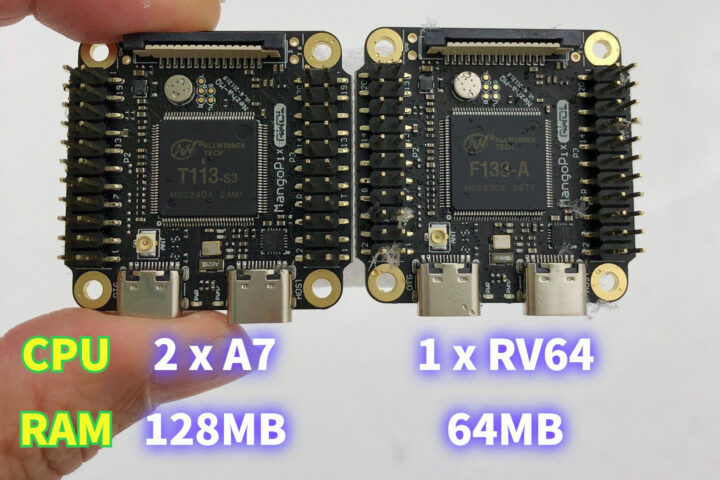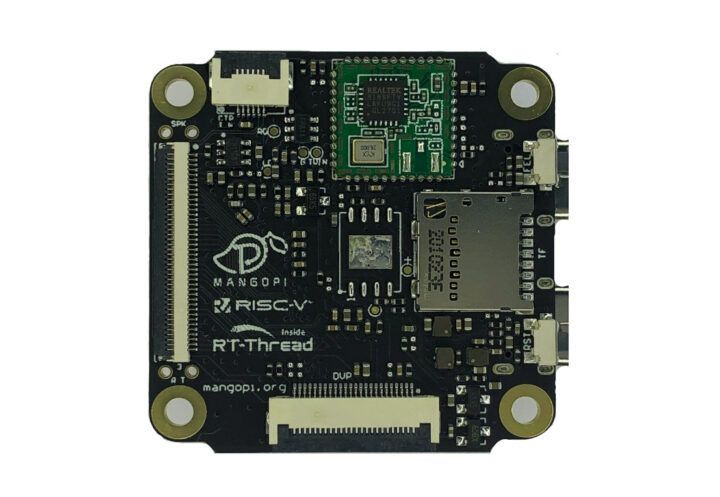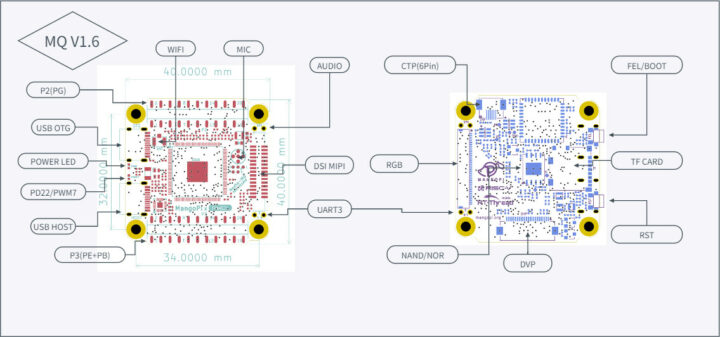Last fall, we wrote about Allwinner D1s/F133-A RISC-V processor and the upcoming MangoPi MQ1, a tiny 4x4cm board based on the processor. The board is not for sale, but we have more details, and the company is also working on an Arm version equipped with Allwinner T113-S3 dual-core Cortex-A7 processor that is pin-to-pin compatible with F133-A SoC.
The Allwinner F133-A board will finally be called MangoPi Nezha-MQ, or MangoPi MQ for shorts, and come with 64MB on-chip RAM while the Allwinner T113-S3 board, with 128MB on-chip RAM, will be named MangoPi MQ-Dual. Both are fitted with a Realtek RTL8189-based Wi-Fi module, offer display and camera interfaces, two USB-C interfaces, and headers for GPIOs.
MangoPi MQ RISC-V or Arm Linux board
MangoPi MQ/MQ-Dual specifications:
- SoC (one or the other)
- MangoPi MQ – Allwinner D1s/F133-A 64-bit RISC-V processor @ 1 GHz with 64 MB DDR2
- MangoPi MQ-Dual – Allwinner T113-S3 32-bit dual-core Arm Cortex-A7 processor with 128 MB DDR3
- Storage
- MicroSD card slot
- Footprint for SPI NAND/NOR flash
- Display I/F
- 15-pin FPC connector Raspberry Pi DSI display
- 40-pin FPC connector for RGB display with 4-wire resistive-touch interface
- 6-pin FPC connector for capacitive touch
- Camera I/F – 24-pin DVP interface (usable as RMII)
- Audio – On-board microphone, audio output via 2-pin header (unpopulated)
- Connectivity
- 2.4 GHz WiFi 4 via Realtek RTL8189 module plus u.FL antenna connector
- 10/100Mbps Ethernet (RMII) via DVP camera interface (add-on board)
- USB – 2x USB Type-C ports with one USB OTG port and one USB host port
- Expansion – 2 x 22 pin expansion headers
- Misc – Boot/Fel & Reset buttons
- Power Supply – 5V via USB-C port
- Dimensions – 4×4 cm (four fixed assembly feet)
Both Arm & RISC-V boards support Allwinner Tina Linux operating system based on OpenWrt and Melis RTOS based on RT-Thread. One upcoming crowdfunding campaign on Crowd Supply for the RISC-V board also mentions RT-Smart developed by RT-Thread and described as a “high-performance microkernel operating system for professional, real-time applications.”. I’m not sure how it differs from RT-Tread IoT OS or Melis RTOS. Since memory is limited, the LVGL open-source graphics library will be used for demos using the displays. Hardware resources and demo firmware can be found on Github. There’s also a separate repository for MQ-Dual for it’s mostly empty for now with a photo and a description of the board.

Jean-Luc started CNX Software in 2010 as a part-time endeavor, before quitting his job as a software engineering manager, and starting to write daily news, and reviews full time later in 2011.
Support CNX Software! Donate via cryptocurrencies, become a Patron on Patreon, or purchase goods on Amazon or Aliexpress








The MangoPi Risc-V was promised for November 2021. Not so.
If you want to experiment with RISC-V 64bit and Linux, a nice choice is the Lichee Sipeed RV with dock. It has 512 MB RAM, and runs Debian (including GUI). Available for 33 Euro (board + dock), incl Shipping and EU VAT. Available from Aliexpress.
I’ve been using it since January 2022, and it’s a very nice first step into RV64.
EDIT: Full name: Sipeed Lichee Rv Dock Allwinner D1 Development Board RISC V Linux Starter Kit
That’s too expensive. MQ-Pro for only $19.9, end of the month。(D1 + 512MB)All-in-One
Which Linux image? Same debian as for the Sipeed Lichee (which is limited), or your own debian/ubuntu image (with more drivers)?
And about price and ETA … we’ll see about that.
Do you have an idea when the T133-S3 board will be available and where? And what about the price?
>Since memory is limited, the LVGL open-source graphics library
>will be used for demos using the displays.
From my limited experience of trying to get LVGL to build it seems very much “not production ready” and is really just software image blitting on a dumb surface.
The datasheet for the T133-S3 was added 1/2h ago : https://github.com/mangopi-sbc/MQ-Dual/blob/main/T113-S3_Datasheet_V1.2.pdf
This chip would make excellent smart speaker or smart display. Do we have an approximate price for it? $4 or less it would be good value. More than $4 it will compete with older CPUs paired with external DRAM.
These prices are no longer realistic with the current chip crunch. You can probably double them in the current context.
Maybe MangoPi people will answer with real price form Allwinner. If that chip is $8 it is going nowhere. The shortage is not effecting chips evenly. For example we removed a STM8 from a board because it went up 500% (to $1.55) we replaced it with a chip from Taiwan that has only gone up from 20 to 25 cents.
That is really nice, could you share me the model of mcu?
One of the Padauk chips, these are not drop in replacements. You need to write new code which we did.
Cool, thanks for sharing! I’m seeing that TjMax is 125°C, which should leave enough margin to keep it within specs without any heatsink.